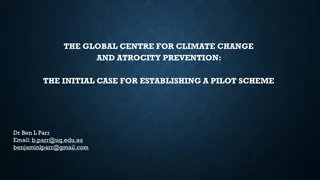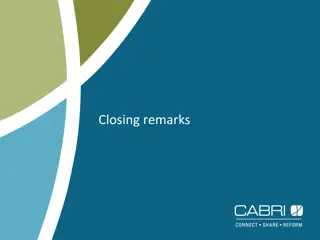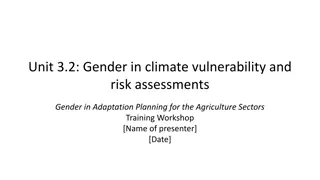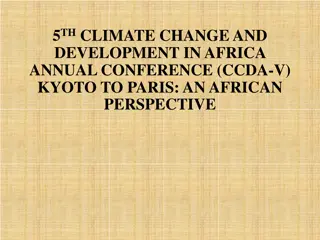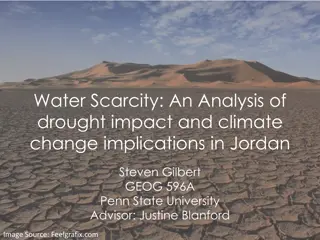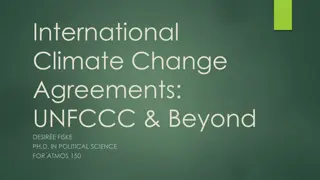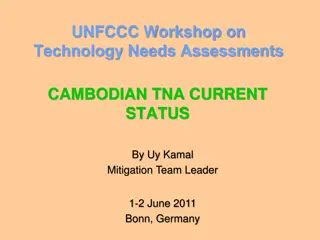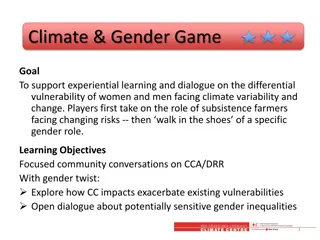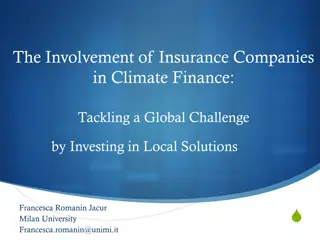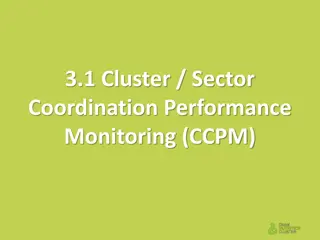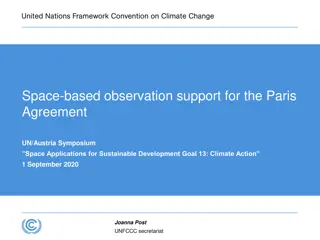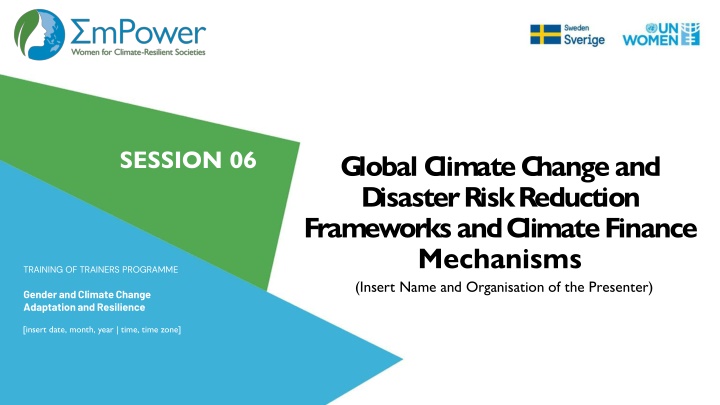
Global Climate Change and UNFCCC: Gender Perspective Journey
Evolution of gender equality at UNFCCC through COP milestones, highlighting the progress in increasing women's participation and the adoption of Gender Action Plans for effective climate action.
Download Presentation

Please find below an Image/Link to download the presentation.
The content on the website is provided AS IS for your information and personal use only. It may not be sold, licensed, or shared on other websites without obtaining consent from the author. If you encounter any issues during the download, it is possible that the publisher has removed the file from their server.
You are allowed to download the files provided on this website for personal or commercial use, subject to the condition that they are used lawfully. All files are the property of their respective owners.
The content on the website is provided AS IS for your information and personal use only. It may not be sold, licensed, or shared on other websites without obtaining consent from the author.
E N D
Presentation Transcript
SESSION 06 Global C limate C hange and Disaster Risk Reduction Frameworks and Climate Finance Mechanisms (Insert Name and Organisation of the Presenter) TRAINING OF TRAINERS PROGRAMME Gender and Climate Change Adaptation and Resilience [insert date, month, year | time, time zone]
Section 1 Global Climate Change Framework
United Nations Framework Convention for Climate Change (UNFCCC) Agreed upon in 1992 at the Earth Summit at Rio de Janeiro (Brazil) The primary objective is to stabilize GHG emissions to prevent human-induced climate change UNFCCC provides a legal framework that has enabled negotiations over various climate agreements every year at the Conference of Parties (COP)
UNFCCC continued The COP is the highest decision-making authority of the UNFCCC and a key forum for all international climate events since COP 1 (1995) Important agreements agreed upon at the various COPs include Kyoto Protocol, 2005 Bali Action Plan, 2007 Paris Agreement, 2015
Gender at UNFCCC: Journey so far COP 18 COP 16 Doha (2010) COP 7 Marrakesh (2001) COP 13 Bali (2007) Geneva (2012) Adopted first text on gender equality and women s participation Opened doors for CSOs especially women s organisations to participate Decision to maintain gender balance and women s participation in all COP and related events Accepted gender equality and women s participation as key element for effective climate action From no initial mandate, the UNFCCC now has over 50 mandates on gender equality
Gender journey continued COP 23 COP 25 COP 21 Paris (2015) COP 20 Lima (2014) Madrid (2019) Bonn (2017) Lima Work Programme in Gender (LWPG) was adopted Endorsed human rights and gender equality as an important aspect of climate action Enhanced Loma Work Programme on Gender and GAP was adopted LWPG adopted the Gender Action Plan (GAP) The COP now has a standing agenda on gender and climate change
Lima Work Programme on Gender (LWPG) UNFCCC Secretariat to review the implementation of all gender-related mandates Training and awareness-raising for delegates on gender-responsive climate policy Training and capacity building for women delegates Two in-session workshops on gender in relation to mitigation, technology, adaptation, and capacity building Technical paper by the Secretariat on guidelines for implementing gender considerations in climate change activities Appointment of a senior focal point on gender at the UNFCCC Secretariat. 83 parties have nominated gender focal points (Jan 2021)
Gender Action Plan (GAP) GAP focus areas GAP priority areas taking into account human rights in climate action Capacity building, knowledge management, and communication Gender balance, participation and women s leadership being inclusive of the unique challenges experienced by indigenous people Coherence and consistent implementation of gender-related mandates and activities promoting action in developing gender-responsive climate technology solutions Gender-responsive implementation and means of implementation preserving traditional knowledge Monitoring and reporting
Section 2 International Disaster Risk Reduction (DRR) Framework
International Frameworks for Disaster Risk Reduction 2005-2015: Hyogo Framework for Action (HFA) 2015-2030: The Sendai Framework for Disaster Risk Reduction (DRR) The key features of the Sendai Framework include: Strong emphasis on disaster risk management as opposed to disaster management Focus on prevention, mitigation, preparedness, response, recovery, and rehabilitation The recognition of climate change as exacerbating disasters and a driver of disaster risk Calling for the coherence of DRR, sustainable development, climate change, and other policies for improving efficacy and efficiency
The Sendai Framework for DRR Outcome: Substantial reduction of disaster risks and losses in lives, livelihoods and health Goal: Prevent new and reduce existing disaster risk through the implementation of integrated and inclusive measures that prevent and reduce hazard exposure and vulnerability to disaster, increase preparedness for response and recovery, and thus strengthen resilience Priorities: Building policies and practices on understanding of risk, vulnerability, capacity, and exposure Strengthen disaster risk governance Investing in DRR to build resilience capacities Enhance disaster preparedness, build back better Empowering women and persons with disabilities to take lead
Global Targets of the Sendai Framework Substantially reduce global disaster mortality Substantially reduce the number of affected people globally Reduce direct disaster economic loss in relation to global gross domestic product (GDP) Reduce disaster damage to critical infrastructure and disruption of basic services, among them health and educational facilities Increase the number of countries with national and local disaster risk reduction strategies Enhance international cooperation to support national actions Increase the availability of and access to multi-hazard early warning systems and disaster risk information and assessments to people
Gender in Sendai Framework Recognizes gender considerations as a priority for enhanced disaster preparedness Recognizes role of women as key stakeholder for effective disaster risk management Women and their participation are critical to effectively managing disaster risk and designing, resourcing and implementing gender-sensitive disaster risk reduction policies, plans and programmes; and adequate capacity building measures need to be taken to empower women for preparedness as well as to build their capacity to secure alternate means of livelihood in post-disaster situations. Disaster risk reduction requires an all-of-society engagement and partnerships It also requires empowerment and inclusive, accessible and non- discriminatory participation, paying special attention to people disproportionately affected by disasters, especially the poorest. A gender, age, disability and cultural perspective should be integrated in all all policies and practices, and women and youth leadership should be promoted. In this context, special attention should be paid to the improvement of organized voluntary work of citizens.
Section 3 Climate Finance
Global Climate Finance Architecture International Finance Private (JI and CDM) Bilateral (Multicountry) Multilateral (Non UNFCCC) Multilateral (UNFCCC) Bilateral (Single Country) MDBs and UN Agencies CIF AF GCF GEF NAMA Facility GCCI CTF SCF FCPF LDCF GCPF DFAT PPCR UN-REDD SCCF GCCA CIDA SREP ASAP DFID GIZ KfW USAID SIDA Other Countries
Climate Finance in Asia 250 1400 1304 214.6 1200 200 1000 828 150 133.3 132.2 800 636 600 100 477 408 400 54.2 298 289241224178 167 163143129 120 49.2 44.2 41.9 38.8 50 36.2 36.1 200 0 0 Lao PDR India Bhutan Sri Lanka Maldives Cambodia Pakistan Nepal Bangladesh Myanmar India Lao PDR Vietnam Cambodia Indonesia China Sri Lanka Pakistan Tajakistan Phillipines Thailand Bangladesh Mongolia Kazakistan Nepal Top 10 Recipient Countries of Adaptation Finance in Asia (USD Millions) Top 15 Recipient Countries of Climate Finance in Asia (USD Millions)
Gender in Global Climate Finance Only 31 per cent of Overseas Development Assistance (ODA) on climate change in 2014, also supported gender equality That s USD 8 billion out of USD 26 billion Gender integration was higher in adaptation than mitigation 41 percent in adaptation only projects compared to 18 percent in mitigation only
Gender in climate finance continued Sectoral variations are also high Agriculture has the most integration (59 per cent), followed by water (39 per cent) Energy sector, which receives maximum bilateral climate aid had only 8 per cent Around 19 per cent of all gender-responsive bilateral climate aid (USD 1.4 billion) was channelled through civil society organizations (CSOs) However much of this (USD 1 billion) went to donor country CSOs as against recipient country CSOs Only a very small amount (2 per cent of USD 132 million) went to CSOs in developing countries Female representation in the governing bodies of the major climate funds is also limited- an average 22 per cent in 2015
Key Adaptation Funds Adaptation Fund (AF) Green Climate Fund (GCF) Established: 2001 Fully operational: 2010 Established: 2010 Fully operational: 2015 Focus on vulnerable communities Funding access: Multilateral development banks, international commercial banks and UN agencies, as well as directly through accredited National, Regional and Sub-National Implementing Entities Scope for engagement Direct Access Entity (DAE)- Seek accreditation and submit projects International Access Entity (IAE)- engage as gender experts Now mandated to serve the Paris Agreement through its Medium Term Strategy 2018-2022 Funding access: Accredited Implementing Entities (NIEs, RIEs and MIEs) Type of grants Project Grants Readiness Grant Funding Innovation Grant Learning Grant
Insert photo within the green frame Thank You !


